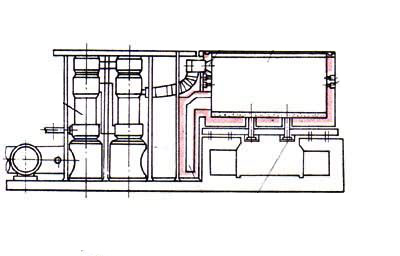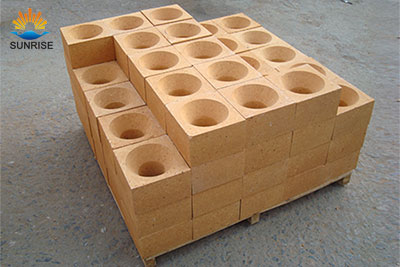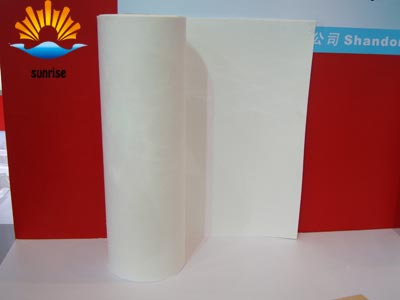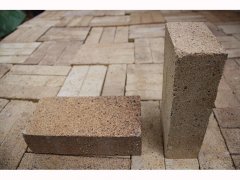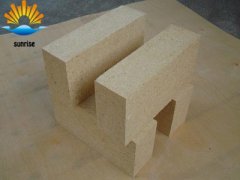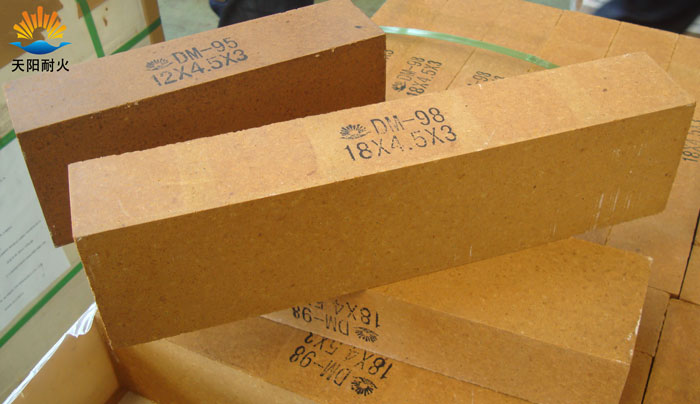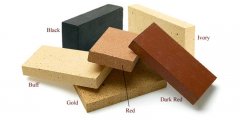A soaking furnace is a thermal device used for heating and soaking the steel ingots in a primary rolling plant. The refractory materials used gradually turn from refractory bricks to monolithic materials. The service life of the furnace has been greatly improved.
The one-side upper burner heating exchanging soaking furnace has a compact layout of pits, a large loading capacity of steel ingots, high quality steel burning, high fuel efficiency and easy-to-automatically-control. It is an important furnace type today.
The furnace is square or rectangular pit composed of the hearth, walls and cover.
The furnace walls are composed of the side walls and end walls. Depending on the height of the ingot, the wall is generally 3-5m high and about 580mm thick. When the wall is too high, tensile resistant bricks or metal anchors are set on the middle or upper part of the walls to enhance the stability of the wall. The walls are damaged rapidly by high temperature, sudden changes in temperature, slag erosion and mechanical wear and collision when ingots are loaded into the gripper. Thus, the service life of the walls determines the service life of the furnace.
The middle and lower part of the walls is built with silica bricks. Silica bricks have high strength, high cold crushing temperature, low expansion coefficient above 760℃ and good volume stability. And a thin layer of deteriorated layer is formed on the surface and there is no structural spalling, so the furnace has a long service life, about 1-2a. The bottom of the walls should be protected with a layer of magnesia bricks or magnesia chrome bricks to resist the corrosion of iron oxide slags. The upper part of the walls is built with
fire clay bricks and high alumina bricks. For tube furnaces, sand sealing bricks filled with quartz are then laid on them to make it easy for sand sealing knives to insert and ensure the tightness of the furnace. When the walls are built with high alumina bricks, the service life of one-side upper burner heating exchanging soaking furnace is about 2a.
The middle and upper part of the walls are built with large prefabricated blocks made of phosphoric acid or sodium silicate refractory castables. Since the blocks can be mechanically lifted, the construction is quick and the intensity of the labor is low. The service life can be prolonged compared to the refractory bricks. High alumina refractory plastic materials or clay bonded high alumina refractory castables should be used in conjunction with high alumina anchor bricks with a center distance of 400-600mm. They are rammed or casted into walls. The walls have better integrity, high temperature strength and high spalling resistance. The service life is 3-6a. Other parts like IF furnace and furnace mouth are usually casted with corundum mullite refractory castables, ultra-low cement or cement-free refractory castables. Their service life can exceed 2a.
On the lower part of the wall, there is an exhaust vent or fuel inlet. It is usually arc shaped, and built with refractory bricks or monolithic castables. It can better withstand the vertical load of the walls and ensure its good working condition.
The bottom is built with fire clay insulation bricks and fire clay bricks. The bottom bears the load of steel ingots and the charge and is subjected to high temperature and molten slags. The working layer is built with different bricks depending on the type of the furnace and the working conditions.
When liquid slagging operation is used, if the bottom working layer is built with magnesia bricks or magnesia chrome bricks, the furnace can be used for 1a. When dry slagging operation is used, if the bottom working layer is built with high alumina bricks, a 400-500mm layer of serpentine or olivine mixed with a small amount of coke is laid on the top to make it easy to place ingots and slag. This bottom can be used for 1-3a. The burner of the bottom center burner soaking furnace is built with high alumina bricks and 400-800mm higher than the bottom.
The furnace cover is composed of metal frame, refractory lining and heat-resistant steel sand machine knives. There are two kinds of covers: arch type and flat-topped suspending type. It is started and moved with the manipulator to load and discharge materials. The cover lining is subjected to the mechanical vibration, sudden changes on temperature and high-temperature flame erosion. The autoclave reactor is easily damaged. Therefore, fire clay bricks or high alumina bricks with food thermal shock resistance are used in the lining. The cover of the bottom center burner soaking furnace is directly subjected to high temperature flame and air flow erosion. The operating temperature is high, up to about 1500℃ when melting the slags. Its service life usually does not exceed six months. The service life of the cover of dry slagging soaking furnaces is about 1a. The cover of one-side upper burner heating exchanging soaking furnaces are casted with 1.8g/m3 high alumina refractory castables. High alumina suspending bricks with a pitch of 300mm are embedded within the lining. The lining has light weight, good insulation and low thermal capacity. It can save energy and can be used for over 1a. When the working lining is built with high alumina refractory plastic materials or clay bonded refractory castables, an insulation layer is laid on it. It can not only save energy, but also expand the service life to 2a or more.
Burner bricks are used in conjunction with burners to organize flame and stabilize combustion. Burner bricks are an important part of one-side upper burner heating exchanging soaking furnaces and four-corner burner soaking furnaces. The former is installed on the upper part of one side end wall with an exhaust vent set on the lower part. Flame and air move in U pattern in the furnace. The latter is installed on the four corners in the furnace with an exhaust vent set on the lower part. The flame forms whirling airflow. Burner bricks are bell-shaped. Its structure is suitable for secondary hot air combustion. So it has big size and weight. It is usually built with two or four fire clay bricks or high alumina bricks or phosphoric acid or low cement castables. Under normal operating conditions, it can be used for 8-15 months.
A regenerator is an important part of regenerative soaking furnaces, connected with exhaust vents in the lower part of end walls. The circumferential walls and common partition walls as well as the common domes are built with fire clay bricks. The partition walls should be well sealed to prevent gas and air communication. Fire clay checker bricks are built in each chamber to increase regenerative capacity. The upper part of the checker work should be built with high aluminum checker bricks to resist chemical attack.
The heat exchanger is an important part of bottom center burner soaking furnaces, four-corner burner soaking furnaces and one-side upper burner soaking furnaces for preheating air or gas. The heat exchanger of the former two furnaces is disposed outside both side walls, while the latter is disposed outside the end wall with burners. They are all located in the flue and connected with the exhaust vent and the hearth. The heat exchanger is built with fire clay brick including four-hole, circular or octagonal fire clay bricks and clay silicon carbide tubes. The preheating temperature of air and coal gas is high, but the air leakage rate is high. The service life is about 1a. When using high alumina silicon carbide refractory castables, circular pipe bricks by centrifugation molding are used. They are 2m long or more. Since there are fewer joints, it reduces the leakage rate and increases the service life by about 50%.
